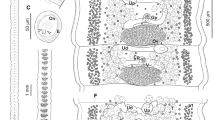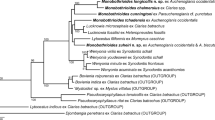Abstract
A new monozoic cestode, Parabreviscolex niepini n. gen. and n. sp. (Cestoda: Caryophyllidea), is described from the type-host Schizopygopsis younghusbandi Regan, 1905 (Cyprinidae: Schizothoracinae) and Schizothorax waltoni Regan, 1905 (Cyprinidae: Schizothoracinae) in the Yarlung Tsangpo River, the upper tributary of the Brahmaputra River on the Tibetan Plateau. The new genus is placed in the Capingentidae because the vitellarium is situated partly in the medullary and cortical parenchyma, i.e., neither completely external nor internal to inner longitudinal muscles. Parabreviscolex n. gen. is characterized by possessing an afossate and cuneiform scolex; numerous vitelline follicles and testes present immediately after the scolex, and spread backward near the cirrus sac; the uterus does not loop anterior to the cirrus sac; genital pores separate, opening to the common genital atrium; the pre-ovarian vitelline follicles lateral and median, post-ovarian vitelline follicles present; ovary H-shaped, compact, and ovarian arms long, anteriorly reaching the cirrus sac. Homology search by the basic local alignment search tool (BLAST) showed that the partial 18S rDNA and complete mtDNA cox-1 sequences obtained in this report were not consistent with any sequences available in GenBank, and molecular phylogenetic analyses revealed Parabreviscolex formed a separated long branch within the caryophyllideans from cyprinids.





Similar content being viewed by others
References
Ash A, Scholz T, Oros M, Levron C, Kar PK (2011) Cestodes (Caryophyllidea) of the stinging catfish Heteropneustes fossilis (Siluriformes: Heteropneustidae) from Asia. J Parasitol 97(5):899–907. https://doi.org/10.1645/GE-2661.1
Brabec J, Scholz T, Králová-Hromadová I, Bazsalovicsová E, Olson PD (2012) Substitution saturation and nuclear paralogs of commonly employed phylogenetic markers in the Caryophyllidea, an unusual group of non-segmented tapeworms (Platyhelminthes). Int J Parasitol 42(3):259–267. https://doi.org/10.1016/j.ijpara.2012.01.005
Chen Y, Cao W (2000) Schizothoracinae. In: Yue P (ed) Fauna Sinica (Osteichthyes:Cypriniformes), vol 3. Science Press, Beijing, pp 273–390 (in Chinese)
Chen F, Chen YF, He DK (2009) Age and growth of Schizopygopsis younghusbandi younghusbandi in the Yarlung Zangbo River in Tibet, China. Environ Biol Fish 86(1):155–162. https://doi.org/10.1007/s10641-008-9370-6
Fotedar DN (1958) On a new caryophyllaeid cestode, Adenoscolex oreini gen. et. sp. nov. from fresh-water fish in Kashmir, and a note on some related genera. J Helminthol 32(1-2):1–16. https://doi.org/10.1017/S0022149X00019301
Guo SS, Zhang GR, Guo XZ, Wei KJ, Yang RB, Wei QW (2014) Genetic diversity and population structure of Schizopygopsis younghusbandi Regan in the Yarlung Tsangpo River inferred from mitochondrial DNA sequence analysis. Biochem Syst Ecol 57:141–151
Kulakovskaya OP (1962) A new genus and species of caryophyllidean cestodes Breviscolex orientalis (Caryophyllaeidae, Cestodes) from fishes of the Amur basin. Dokl Akad Nauk SSSR 143:1001–1004 (in Russian)
Kumar S, Stecher G, Tamura K (2016) MEGA7: molecular evolutionary genetics analysis version 7.0 for bigger datasets. Mol Biol Evol 33(7):1870–1874. https://doi.org/10.1093/molbev/msw054
Li WX, Zhang LQ, Gao Q, Nie P (2008) Endohelminths and their community characteristics in fish of the Lhasa River in Tibet of China. Chin J Zool 43:1–8
Mackiewicz JS (1970) Edlintonia ptychocheila gen. n., sp. n. (Cestodia: Capingentidae) and other caryophyllid tapeworms from cyprinid fishes of North America. Proc Helminthol Soc Wash 37:110–118
Mackiewicz JS (1972) Caryophyllidea (Cestoidea): a review. Exp Parasitol 31(3):417–512. https://doi.org/10.1016/0014-4894(72)90103-8
Mackiewicz JS (1994) Order Caryophyllidea van Beneden in Carus, 1863. In: Khalil LF, Jones A, Bray RA (eds) Keys to the cestode parasites of vertebrates. CAB international, Wallingford, pp 21–43
Oros M, Hanzelová V, Scholz T, Mackiewicz JS (2008) Phylogenetic relationships of the monozoic tapeworms (Eucestoda: Caryophyllidea) inferred from morphological characters. Syst Parasitol 70(1):1–14. https://doi.org/10.1007/s11230-008-9133-y
Oros M, Scholz T, Hanzelová V, Mackiewicz JS (2010) Scolex morphology of monozoic cestodes (Caryophyllidea) from the Palaearctic region: a useful tool for species identification. Folia Parasitol 57(1):37–46. 10.14411/fp.2010.006
Oros M, Ash A, Brabec J, Kar PK, Scholz T (2012) A new monozoic tapeworm, Lobulovarium longiovatum n.g., n. sp. (Cestoda: Caryophyllidea), from barbs Puntius spp. (Teleostei: Cyprinidae) in the Indomalayan region. Syst Parasitol 83(1):1–13. https://doi.org/10.1007/s11230-012-9367-6
Oros M, Brabec J, Kuchta R, Choudhury A, Scholz T (2016) A synoptic review of Promonobothrium Mackiewicz, 1968 (Cestoda: Caryophyllidea), parasites of suckers (Catostomidae) in North America, with description of two new species. Folia Parasitol 63:008
Ronquist F, Huelsenbeck JP (2003) MrBayes 3: Bayesian phylogenetic inference under mixed models. Bioinformat 19(12):1572–1574. https://doi.org/10.1093/bioinformatics/btg180
Schmidt GD (1986) CRC Handbook of tapeworm identification. CRC Press, Boca Raton, Florida, pp 675
Scholz T, Shimazu T, Olson PD, Nagasawa K (2001) Caryophyllidean tapeworms (Platyhelminthes: Eucestoda) from freshwater fishes in Japan. Folia Parasitol 48:275–288
Scholz T, Brabec J, Kráľová-Hromadová I, Oros M, Bazsalovicsová E, Ermolenko A, Hanzelová V (2011) Revision of Khawia spp. (Cestoda: Caryophyllidea), parasites of cyprinid fish, including a key to their identification and molecular phylogeny. Folia Parasitol 58(3):197–223. 10.14411/fp.2011.020
Scholz T, Oros M, Bazsalovicsová E, Brabec J, Waeschenbach A, Xi BW, Aydoğdu A, Besprozvannykh V, Shimazu T, Králová-HromadováIvica I, Littlewood DTJ (2014) Molecular evidence of cryptic diversity in Paracaryophyllaeus (Cestoda: Caryophyllidea), parasites of loaches (Cobitidae) in Eurasia, including description of P. vladkae n. sp. Parasitol Int 63:841–850
Scholz T, Oros M (2017) Caryophyllidea van Beneden in Carus, 1863. In: Caira JN, Jensen K (eds) Planetary biodiversity inventory (2008–2016): tapeworms from vertebrate bowels of the earth. University of Kansas, Natural History Museum, Lawrence, special publication no. 25, pp 47–64
Scholz T, Oros M, Choudhury A, Brabec J, Waeschenbach A (2015) New circumscription of freshwater fish parasites Monobothrium Diesing, 1863 and Promonobothrium Mackiewicz, 1968 (Cestoda: Caryophyllidea) using morphological and molecular evidence. J Parasitol 101(1):29–36. https://doi.org/10.1645/14-610.1
Waeschenbach A, Webster BL, Littlewood DTJ (2012) Adding resolution to ordinal level relationships of tapeworms (Platyhelminthes: Cestoda) with large fragments of mt DNA. Mol Phylogenet Evol 63(3):834–847. https://doi.org/10.1016/j.ympev.2012.02.020
Wang XZ, Gan XN, Li JB, Mayden RL, He SP (2012) Cyprinid phylogeny based on Bayesian and maximum likelihood analyses of partitioned data: implication for Cyprinidae systematics. Sci China Life Sci 55(9):761–773. https://doi.org/10.1007/s11427-012-4366-z
Xi BW, Oros M, Wang GT, Wu SG, Gao S, Nie P (2009) Khawia saurogobii n. sp. (Cestoda: Caryophyllidea) from freshwater fish Saurogobio spp. (Cyprinidae) in China. J Parasitol 95 (12):1516–1519
Xi BW, Barčák D, Oros M, Chen K, Xie J (2016) The occurrence of the common European fish cestode Caryophyllaeus laticeps (Pallas, 1781) in the River Irtysh, China: a morphological characterization and molecular data. Acta Parasitol 61(3):493–499. https://doi.org/10.1515/ap-2016-0065
Xi BW, Oros M, Wang GT, Scholz T, Xie J (2013) Khawia abbottinae sp. n. (Cestoda: Caryophyllidea) from the Chinese false gudgeon Abbottina rivularis (Cyprinidae: Gobioninae) in China: morphological and molecular data. Folia Parasitol 60(2):141–148. 10.14411/fp.2013.015
Yang WC (2007) A list of fish cestodes reported from China. Syst Parasitol 68:71–78
Yoneva A, Levron C, Oros M, Orosová M, Scholz T (2011) Ultrastructure of spermiogenesis and mature spermatozoon of Breviscolex orientalis (Cestoda: Caryophyllidea). Parasitol Res 108(4):997–1005
Zhang C, Cai B, Xu T (1995) Fishes and fish resources in Xizang, China. China Agriculture Press, Beijing, pp 110–111 (in Chinese)
Acknowledgments
We thank Dr. Qing-Rui Yang (China Institute of Water Resources and Hydropower Research) for his help in sampling in Tibet. Thanks are due to Daniel Barčák, Institute of Parasitology SAS, Košice, Slovakia, for preparing the SEM photomicrographs.
Funding
This work is funded by the Natural Sciences Foundation of China (31302222, 31572662), the earmarked fund for China Agriculture Research System (CARS-45), and the Slovak Grant Agency VEGA (No. 2/0159/16) and the Research & Development Operational Programme funded by the ERDF (code ITMS:26220120022) (0.3).
Author information
Authors and Affiliations
Corresponding authors
Rights and permissions
About this article
Cite this article
Xi, BW., Oros, M., Chen, K. et al. A new monozoic tapeworm, Parabreviscolex niepini n. g., n. sp. (Cestoda: Caryophyllidea), from schizothoracine fishes (Cyprinidae: Schizothoracinae) in Tibet, China. Parasitol Res 117, 347–354 (2018). https://doi.org/10.1007/s00436-017-5682-9
Received:
Accepted:
Published:
Issue Date:
DOI: https://doi.org/10.1007/s00436-017-5682-9




